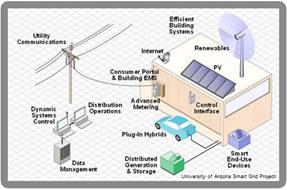Smart Grid & Smart Meters
 Electrical Safety Foundation International (ESFI), http://www.esfi.org/
Electrical Safety Foundation International (ESFI), http://www.esfi.org/
Electricity is a critical part of modern lives, but it is often taken for granted. How does the electricity you need to watch your TV or wash your clothes get to your home? It travels through the electrical grid, an interconnected network of generating plants, transmission lines, and transformers.
What is Smart Grid?
Smart Grid refers to an improved electricity delivery system that includes monitoring, analysis, control, and communications capabilities. These “smart” technologies allow utilities to deliver electricity to homeowners and businesses as efficiently and economically as possible.
Why do we need a “smarter” grid?
In many areas of the United States, the existing electrical grid is getting old and worn out. In addition, population growth in some areas has caused the entire transmission system to be over used and fragile. Smart Grid technologies can improve the reliability, security, and efficiency of the electrical grid. A “smarter” grid will also allow for better integration of emerging technologies like solar power systems and electric vehicle charging stations.
Residential Smart Meters
Smart grids provide a cost and energy efficient method for managing power on a large scale, but smart meters take that technology a step further, constantly monitoring and recording the amount of energy flowing to each specific customer. Unlike traditional meters that provide only one-way communication to the utility, smart meters allow for two way communication between the utility and the customer, providing valuable information to help customers better manage their energy use to save money and conserve energy.
Smart meters are provided and installed by your local utility company in place of their traditional meter. Check with your utility regarding their plans for smart meter upgrades.
Identified Challenges
Privacy– Instead of traditional one-way communication between the generation plant and the home or business, smart meters allow for two-way communication with the smart grid. Some are concerned that this type of communication, which involves the sharing of personal information including when you are home and what you are doing, is a violation of privacy.
Encryption– As with other wireless technologies, smart devices are potentially vulnerable to hacking and other cyber-attacks. Utility companies are taking steps to ensure the security of smart meter data through encryption and other cyber security measures, adapting security protocols developed for the banking and defense sectors
Radio Frequency (RF) Exposure– Household electronic devices, such as cell phones, wireless routers, and smart meters, produce RF emissions. Extremely high levels of RF exposure can be harmful to your health. In the U.S., the Federal Communications Commission (FCC) regulates the amount of RF energy that electronic devices, including smart meters, are allowed to emit in order to protect public health. Properly installed and maintained wireless smart meters result in much smaller levels of RF exposure than other common household devices, particularly cell phones and microwaves.
Costs– Upgrading substations, lines, poles, meters, and communications systems, in addition to replacing aging equipment, is an expensive undertaking. Estimates for the deployment of Smart Grid technology in the U.S. range from $338 billion to $476 billion over the next 20 years. There is concern that these costs will ultimately be borne by the consumer.
Safety Considerations
Whether you have a traditional mechanical meter or a smart meter, you should not attempt to alter, service/repair or remove the meter. Installation and service should only be performed by utility company personnel or their approved contractors.
Keep the area around your meter and electrical panel clear for ease of access.



